- Clone
- W16016A (See other available formats)
- Regulatory Status
- RUO
- Other Names
- Activating transcription factor 4, Cyclic AMP-dependent transcription factor ATF-4, CREB-2, DNA-binding protein TAXREB67
- Isotype
- Rat IgG2a, κ
- Ave. Rating
- Submit a Review
- Product Citations
- publications
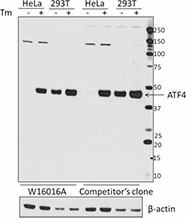
-

Total cell lysates (15 µg protein) from non-treated and Tunicamycin (Tm) treated (2 µg/mL, six hours) HeLa and 293T were resolved by 4-12% Bis-tris gel electrophoresis, transferred to nitrocellulose, and probed with 1 µg/mL purified anti-ATF4 (clone W16016A) antibody or competitor's antibody used at the manufacturers recommended concentration. Proteins were visualized using an HRP goat anti-rat-IgG secondary antibody (clone Poly4054) or secondary antibody appropriate to competitors clone, and chemiluminescence detection. Direct-Blot™ HRP anti-β-actin (clone 2F1-1) antibody was used as a loading control.
| Cat # | Size | Price | Quantity Check Availability | Save | ||
|---|---|---|---|---|---|---|
| 693901 | 25 µg | 81€ | ||||
| 693902 | 100 µg | 221€ | ||||
The ER responds to the accumulation ofunfolded proteins in its lumenby activating intracellular signaling pathways, which is collectively termed the unfolded protein response (UPR). Three major branches of the UPR have been identified, including IRE1 (inositol requiring enzyme 1), PERK [double-stranded RNA-activated protein kinase (PKR)–like ER kinase], and ATF6 (activating transcription factor 6). The second branch of the UPR is mediated by PERK. Upon activation, PERK oligomerizes and phosphorylates itself and the ubiquitous translation initiation factor eIF2a, which inactivates eIF2 and inhibits mRNA translation. In this way, PERK helps reduce the flux of protein entering the ER to alleviate ER stress. In addition, eIF2a phosphorylation preferentially increases the translation of selective mRNAs that contain inhibitory upstream open reading frames (uORFs) within their 5’ untranslated region (UTR) that prevent translation in unstressed cells. The most studied of these genes is ATF4 (activating transcription factor 4). ATF4 belongs to the family of basic zipper-containing proteins. As a transcription factor, three conserved binding sites in the promoter regions of ATF4 target genes have been identified, including CRE site, amino acid response element (AARE) site, and nutrient-sensing response element-1 (NSRE-1) site. Two important target genes driven by ATF4 are CHOP (transcription factor C/EBP homologous protein) and GADD34 (growth arrest and DNA damage–inducible 34). CHOP is a transcription factor that controls genes encoding components involved in apoptosis. GADD34 encodes a PERK-inducible regulatory subunit of the protein phosphatase PP1C that counteracts PERK by dephosphorylating eIF2a.
Lines of evidence have shown that ATF4 plays crucial roles in various physiological and pathological activities, such as ER stress, hematopoiesis, lens and skeletal development, hypoxia resistance, autophagy, amino acid deprivation, learning and memory formation, tumor development and neurodegeneration.
Product Details
- Verified Reactivity
- Human, Mouse
- Antibody Type
- Monoclonal
- Host Species
- Rat
- Immunogen
- Partial human ATF4 (102-351 a.a.) expressed in E. coli.
- Formulation
- Phosphate-buffered solution, pH 7.2, containing 0.09% sodium azide.
- Preparation
- The antibody was purified by affinity chromatography.
- Concentration
- 0.5 mg/ml
- Storage & Handling
- The antibody solution should be stored undiluted between 2°C and 8°C.
- Application
-
WB - Quality tested
- Recommended Usage
-
Each lot of this antibody is quality control tested by Western blotting. For Western blotting, the suggested use of this reagent is 0.2 - 2.0 µg per ml. It is recommended that the reagent be titrated for optimal performance for each application.
- Product Citations
-
- RRID
-
AB_2650719 (BioLegend Cat. No. 693901)
AB_2650719 (BioLegend Cat. No. 693902)
Antigen Details
- Structure
- 351 amino acids with a predicted molecular weight of 39 kD.
- Distribution
- Cytoplasm and nucleus.
- Function
- Transcriptional activator. Upregulates a UPR genes that function preferentially in amino acid import, glutathione biosynthesis, and resistance to oxidative stress.
- Interaction
- Binds DNA as a homodimer and as a heterodimer. Interacts with CEBPB, GABBR1 and GABBR2, FOXO1, SATB2, CEP290, NEK6, DAPK2, ZIPK/DAPK3, TXLNG, DDIT3/CHOP, FAM175B.
- Biology Area
- Cell Biology, Signal Transduction, Transcription Factors
- Antigen References
-
1. Walter P, Ron D. 2011. Science. 334:1081.
2. Hetz C, et al. 2011. Physiol. Rev. 91:1219.
3. Schroder M, Kaufman RJ. 2005. Annu. Rev. Biochem. 74:739.
4. Mielnicki LM, Pruitt SC. 1991. Nucleic Acids Res. 19:6332.
5. Siu F, et al. 2002. J. Biol. Chem. 277:24120.
6. Masuoka HC, Townes TM. 2002. Blood. 99:736.
7. Yang X, et al. 2004. Cell. 117(3):387-98.
8. Ye J, Koumenis C. 2009. Curr. Mol. Med. 9:411.
9. Milani M, et al. 2009. Cancer Res. 69:4415.
10. Wei N, et al. 2015. Mol. Neurobiol. 52:1765.
11. Rozpedek W, et al. 2016. Curr. Mol. Med. 16:533. - Gene ID
- 468 View all products for this Gene ID
- UniProt
- View information about ATF4 on UniProt.org
Related Pages & Pathways
Pages
Other Formats
View All ATF4 Reagents Request Custom Conjugation| Description | Clone | Applications |
|---|---|---|
| Purified anti-ATF4 | W16016A | WB |
Customers Also Purchased

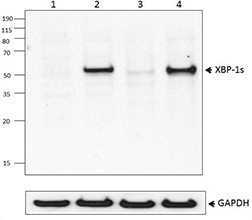
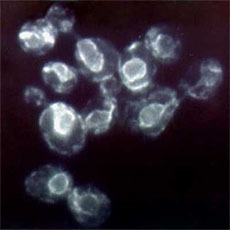
Compare Data Across All Formats
This data display is provided for general comparisons between formats.
Your actual data may vary due to variations in samples, target cells, instruments and their settings, staining conditions, and other factors.
If you need assistance with selecting the best format contact our expert technical support team.
-
Purified anti-ATF4
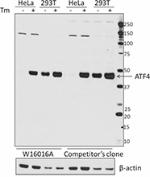
Total cell lysates (15 µg protein) from non-treated an...
 Login / Register
Login / Register 




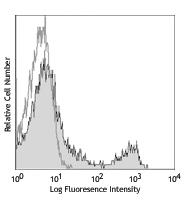



Follow Us